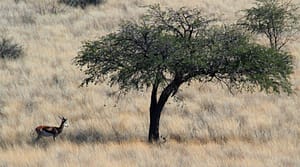Central Kalahari Game Reserve
The dry heart of the dry south of a dry continent, the CKGR is an awesome place. Covering 52,800 sq km, it’s one of Africa’s largest protected areas. This is big-sky country, home to black-maned Kalahari lions, a full suite of predators and a wonderful sense of the remote. In the heart of the park, gemsboks, springboks and bat-eared foxes are common, as are lions, leopards, cheetahs, jackals and brown hyenas; wild dogs are also possible. Estimates by research scientists working in the reserve suggested minimum 2016 populations (including the contiguous Khutse Game Reserve) at around 800 brown hyenas, 500 lions, 300 leopards, 150 African wild dogs, 100 cheetahs and 100 spotted hyenas.
Birds are numerous around the ancient river valleys, with sightings of larger species such as ostriches and kori bustards (the world’s heaviest flying bird) almost guaranteed. Desert-adapted species are other drawcards, with the Kalahari scrub robin, a common visitor to campsites, a much-sought-after prize for twitchers.
Deception Valley
The CKGR is perhaps best known for Deception Valley, the site of Mark and Delia Owens’ 1974–81 brown hyena and lion study, which is described in their cult-classic book Cry of the Kalahari. Deception Valley’s appeal also owes much to the variety of its landscapes. This broad valley, lined on its eastern and western shores by light woodland climbing gentle hills, is all about swaying grasslands, tight clusters of trees and roaming gemsboks, springboks and the occasional predator. It’s a beautiful spot around sunrise or sunset, while Deception Pan, at the southern end of the valley, can feel like the end of the earth at midday. Deception is one of four fossil valleys in the Central Kalahari – the others are the Okwa, the Quoxo (Meratswe) and the Passarge – that were carved out by ancient rivers, bringing topographical relief to the virtually featureless expanses. The rivers themselves ceased flowing more than 16,000 years ago.
Passarge Valley
Passarge Valley is far quieter than Deception Valley. There is a waterhole (artificially pumped to provide water for animals throughout the dry season) at the south-western end of the valley.
Northern CKGR
The 39 km from the Passarge Valley waterhole to Motopi Pan takes you through classic Kalahari country with rolling dune-hills covered in thorn scrub, acacias and light woodland, with some lovely views out across the plains en route. Motopi Pan itself is a lovely spot late in the afternoon, with the waterhole regularly visited by gemsboks, giraffes and ostriches, with lions never far away. The low hills that separate the three Motopi campsites include some of the CKGR’s more varied topography and on one visit we spent an entire morning with a pride of lions around here before another vehicle appeared over the horizon.
The Western Pans
Some 26 km southwest of the main loop through the central section of the reserve, Piper Pans is well worth a visit; you’ll pass through here if you enter the reserve at Xade Gate and plan to head towards Deception Valley, or if you’re completing a north-south (or vice-versa) crossing. The appeal here is a series of interlocking pans encircled by good trails, lightly wooded surrounds and the last of the good wildlife watching if you’re heading south.
The Far South
You’re a long way from anywhere down here. Xade Gate and its campsites inhabit the site of the old San settlement that was based around Xade Pan, although nothing remains in evidence. Wildlife is generally scarce all across the south. The landscapes here are generally flat with golden grasslands, fewer salt pans than further north, and thinly scattered vegetation such as the acacia thorn and Kalahari apple-leaf everywhere.
Khutse Game Reserve
This 2500-sq-km reserve, which is an extension of the southern boundary of the CKGR, is a popular weekend excursion for Gaborone residents, but it’s still deliciously remote and crowds are rare, especially from Sunday to Thursday. It has all the attractions of the Kalahari, including good wildlife watching, well-maintained trails and around 60 mineralised clay pans that once belonged to Africa’s largest inland lake. Leopard and lion sightings are possible, while gemsboks and giraffes are also commonly seen.
Khutse Pan
The crowds of visitors, such as they are, tend to congregate around the Khutse Pan network close to the park entrance. There’s a waterhole here, just a few hundred metres before the turn-off to the Khutse Pan campsites, where you can spot leopards, giraffes and gemsboks. A 7km loop skirts the southern sections of the pan and, unusually, has some elevations that allow for fabulous views close to sunrise and sunset.
Kuru Art Project
This fabulous art project provides opportunities for local artists (14 at last count) to create and sell paintings and other artwork; it’s worth spending an hour or two leafing through the various folios of artworks. Some of the artists here are well known around the world and their works hang in some of the world’s most prestigious art spaces, including the Smithsonian Institute.

